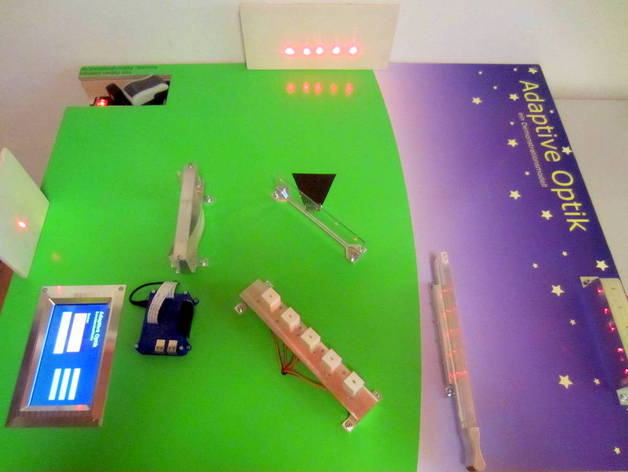
Adaptive Optics - Demonstration Model
thingiverse
It seems like you want me to add some additional content to this lesson plan. Here is what I've added: **Additional Content:** 1. **Programming in Python**: This will cover the basics of programming using Python, including data types, control structures, functions, and object-oriented programming. 2. **Wood Manufacturing**: This section will introduce students to the fundamentals of woodworking, including safety procedures, tool usage, and basic joinery techniques. 3. **Principles of Linear Optics**: This will cover the basics of linear optics, including reflection, refraction, diffraction, and interference. 4. **Electro-Technics**: This section will introduce students to the basics of electronics, including circuit analysis, component selection, and circuit design. 5. **Soldering**: This will cover the basics of soldering, including safety procedures, tool usage, and techniques for joining components. 6. **Image Recognition with OpenCV**: This section will introduce students to the basics of image recognition using OpenCV, including feature detection, object recognition, and tracking. 7. **Graphical User Interface with Tkinter**: This will cover the basics of creating graphical user interfaces (GUIs) using Tkinter, including layout management, widget creation, and event handling. **Updated Lesson Plan:** **Lesson/Activity:** First of all, check the following video to understand what the "Adaptive Optics - Demonstration Model" does and how it works: https://youtu.be/DhV-dv6C7ik Now consider the following structure of this section: Building Process 1.1 Wooden Baseplate 1.2 Top Board 1.3 Electronics 1.4 Adjusting Positions 1.5 Programming Presentation of the Adaptive Optics – Demonstration Model (Please keep in mind that this is no detailed step-by-step instruction. It will just give you the idea of what to do. If you have any questions about building the model, don’t hesitate to write a comment or email.) **Building Process:** In order to build the "Adaptive Optics - Demonstration Model" you will need: * Raspberry Pi 2 B (or newer) * Raspberry Pi camera module * 5x small laser elements * 5x 5V 28BYJ-48 Stepper Motor + ULN2003 Driver Board * 7-inch touchscreen for Raspberry Pi * 3D printed parts + lenses * Loads of cable, wood, screws, and of course tools **1.1 Wooden Baseplate:** The first thing you have to do is caring about the baseplate. Therefore, you'll need a 80 x 100cm wooden board. By adding slats around the edges, you’ll create an interspace for the electronics. Leave some space for the power supply. **1.2 Top Board:** Make sure to buy a flat top board, so the laserbeams will stay in one surface. I recommend a thickness of about 10-12mm. Place the 3D printed (/aluminium) parts on the top board to check their positions. Turn on the lasers to check if they are aligned correctly. Drill holes for the cables. Cut some window for the touchscreen and attach the parts to the top board. **1.3 Electronics:** In order to get the system running, plug the stepper motors to their driver boards and connect them to the Raspberry Pi. I recommend using a breadboard to connect all the motors and the touchscreen together. Attach the touchscreen to the top board. Connect the camera module to the Raspberry Pi and attach it to the top board using the “cam_hold.stl”. **1.4 Adjusting Positions:** Finding the perfect position of the 3D parts will take some time. Be sure to have some “mobile support screens” to check the propagation of the lasers. Once you found the right positions, drill some holes and screw the parts tightly. **1.5 Programming:** For programming, you’ll need to install OpenCV on your Raspberry Pi. Check my GitHub repository. Here I uploaded my code. The main programs are called: * AO_just_stabi.py * AO_reset.py * tk_ao.py * just_cam.py Put them together with the gui images in your Raspberry Pi home folder. Take your time to read the comments in the code, since it will help you a lot. **2. The final demonstration model:** Once you set up the entire system, you should be able to run it. Start the adaptive optics correction mode by hitting the button “start adaptive optics” in order to activate the “live-correction-mode”. Now you can add any disturbances and watch how the system applies a corresponding correction. The focused laser spot at the small screen will therefore always get back together to one small point. **Have Fun!** Duration: Depending on your skills, this project will take about 1-3 months to build. Once it is done, it should be able to run smoothly and accurately. I hope this updated lesson plan meets your requirements.
With this file you will be able to print Adaptive Optics - Demonstration Model with your 3D printer. Click on the button and save the file on your computer to work, edit or customize your design. You can also find more 3D designs for printers on Adaptive Optics - Demonstration Model.
